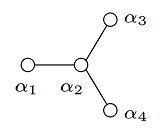Let $\mathfrak g$ be the semisimple Lie algebra of type $D_{4}$. Let $\sigma$ be the 3-rd order automorphism of $\mathfrak g$ induced by the triality of $D_{4}$:
 $$
\sigma:\alpha_{1}\mapsto\alpha_{3}\mapsto\alpha_{4},\alpha_{2}\mapsto\alpha_{2}
$$
$$
\sigma:\alpha_{1}\mapsto\alpha_{3}\mapsto\alpha_{4},\alpha_{2}\mapsto\alpha_{2}
$$
Let $\mathfrak g^{\sigma}$ be the subalgebra of $\sigma$-stable elements of $\mathfrak g$.
How can Serre generators of $\mathfrak g^{\sigma}$ be expressed through Serre generators of $\mathfrak g$?
I suppose that "Serre generators", "Serre-Chevalley generators", and "Chevalley generators" are equivalent terms. (In my opinion, perhaps the use of a Chevalley basis would be more straightforward?)
